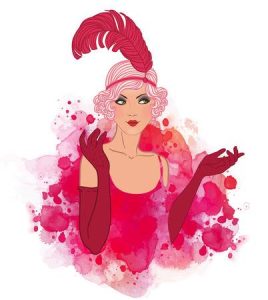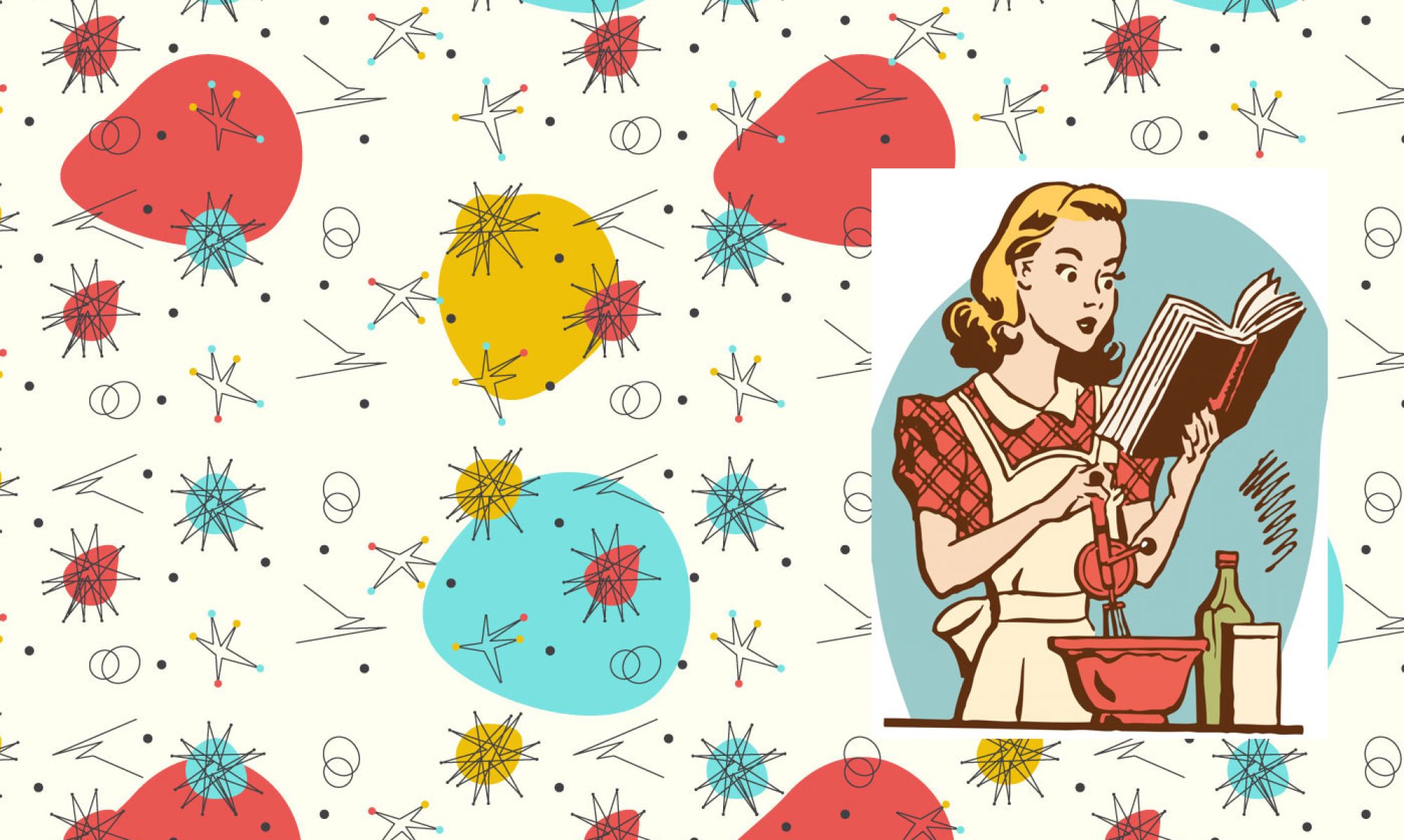I have recently been researching the way the world changed after the First World War. One hundred years can give us some perspective about that time of upheaval. The years that followed the war were a time of great changes and one of the most obvious change was in women’s fashion. Prior to the war women looked like this:
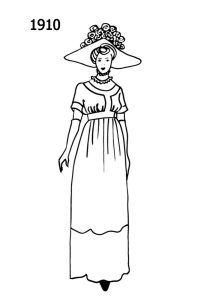
After the war women looked like this:
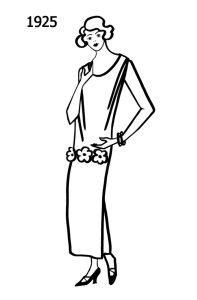
There were many changes in these two simple line drawings. Hats got smaller and closer to the face or were not wore at all. Hair was bobbed. Dresses got looser, shorter and more streamlined to the body. Arms and necks were on display. Shorter skirts meant ankles were seen through sheer stockings. And women started to use makeup. For a Victorian mother or grandmother it must have been scandalous.
Makeup or cosmetics have probably been around as long as people, just think of the Egyptians. In the very proper, appearance conscious and repressed Victorian era only women of ill repute would wear makeup that looked made up. Naturally, lips could be reddened by biting, and cheeks by pinching, just before the first dance with a beau. However, there were some powders, rouges and lip tints available for sale, and it could be made at home. But most women wouldn’t have worn any makeup. Or at least people might not know that some women did as subtlety was key in the application of these rather rudimentary early makeups.
It can hardly be overstated just how hard the war had been on everyone. I think beside the stunning loss of life and unexpected deprivations of war rationing, there was also damage to the human psyche that such a dreadful war could have been allowed to happen. They so wanted it to be the war to end all wars. So, it makes sense that the 1920’s became a time of youthful exuberance. A kind of “let’s party” atmosphere. Everyone wanted to forget the past and just have a good life. There was also a growing women’s movement that had actually started before the war but continued to show itself in things like wearing clothing that were more liveable for the “modern woman” who wanted to do daring things like ride bicycles without long flowing skirts and restrictive corsets.
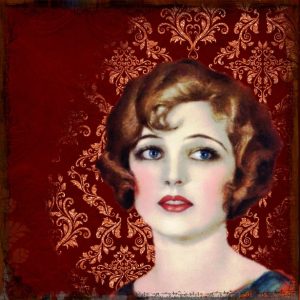 And so we have the Flapper who broke all the old fashion rules. She cut her hair, wore flashy scanty clothing, smoked cigarettes, danced the Charleston and even wore makeup. The makeup was rather crude by our standards today. It was also quite expensive. There was powder, mascara, rouge and lipstick. There weren’t a lot of colour options available and I think Flappers applied it all rather heavy handedly and they over plucked their brows. But it was a new beauty standard. Again, it was shocking at the time.
And so we have the Flapper who broke all the old fashion rules. She cut her hair, wore flashy scanty clothing, smoked cigarettes, danced the Charleston and even wore makeup. The makeup was rather crude by our standards today. It was also quite expensive. There was powder, mascara, rouge and lipstick. There weren’t a lot of colour options available and I think Flappers applied it all rather heavy handedly and they over plucked their brows. But it was a new beauty standard. Again, it was shocking at the time.
Over the next few decades make up became acceptable and affordable for most women to wear every day. Lipstick was considered essential for some. I once spoke with a woman who lived through the Great Depression and one of her strongest memories was how hard it was to get enough spare “cash money” to buy a new lipstick when the old one wore down. She was a young mother and there were often more pressing needs. She talked about using beeswax over a light dab of lipstick to stretch its life a bit longer.
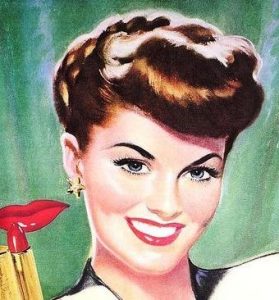 By the 1940’s and the Second World War, being concerned about looking your best in public was expected. Magazines were full of ads for hair products, skin care creams and cosmetics. The formulas for makeup improved to be kinder to the skin and colours became more available to suit more women. (Still not exactly inclusive of all women.) Eyebrows became stronger and more naturally shaped. The overall look was one of health and youth and a lighter hand was favoured. Women often only wore lipstick, and could use it as a blush on cheeks as well. During the war cosmetics were often difficult to find once again. But women made do.
By the 1940’s and the Second World War, being concerned about looking your best in public was expected. Magazines were full of ads for hair products, skin care creams and cosmetics. The formulas for makeup improved to be kinder to the skin and colours became more available to suit more women. (Still not exactly inclusive of all women.) Eyebrows became stronger and more naturally shaped. The overall look was one of health and youth and a lighter hand was favoured. Women often only wore lipstick, and could use it as a blush on cheeks as well. During the war cosmetics were often difficult to find once again. But women made do.
 In the 1950’s eyeshadows and false lashes were frequently used for dramatic evening looks. A somewhat smudged smoky eye was popular. Everyday makeup was still very natural looking. Powder, rouge and lipstick was all you needed. My mother said women never left home without at least lipstick on. Something that I had noticed was that a popular shade of lipstick was an orange-red. You see these red shades being offered in ads in all the magazines of the time. What I found out was movie stars like Marilyn Monroe wore this orange-red shade because it showed up as a rich red on the movie film used at this time. I think this shade is not as flattering as a cherry red, but maybe that is just my preference. I would not have been happy with this shade if I lived in the 1950’s.
In the 1950’s eyeshadows and false lashes were frequently used for dramatic evening looks. A somewhat smudged smoky eye was popular. Everyday makeup was still very natural looking. Powder, rouge and lipstick was all you needed. My mother said women never left home without at least lipstick on. Something that I had noticed was that a popular shade of lipstick was an orange-red. You see these red shades being offered in ads in all the magazines of the time. What I found out was movie stars like Marilyn Monroe wore this orange-red shade because it showed up as a rich red on the movie film used at this time. I think this shade is not as flattering as a cherry red, but maybe that is just my preference. I would not have been happy with this shade if I lived in the 1950’s.
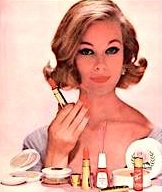 The 1960’s were as revolutionary as the 1920’s in many ways. The prevailing ways of dressing, wearing your hair and wearing makeup , changed a lot over the decade. Think about how decades of wearing similarly styled dresses in the thirties, forties and fifties gradually became out of fashion and young women started to wear slim fitted suits, then miniskirts and pantsuits and finally jeans and peasant skirts. By the 1960’s a whole world of colour for makeup also opened up. Foundation, powder, blush and lipstick was typical for everyday wear. As was eyeshadow in much bolder colours. We have all seen the bright blue and green eyeshadow trend that started in the sixties and lasted a long while . In fact the first pallette of eyeshadow I every bought in the mid 1970’s was four pans; baby blue, baby green, white and black. Imagine how you could muck that up in your first try at eyeshadow. Blush and lipstick colour ranges increased too, and shades of pink became popular. Almost any shade of blush and lipcolour you can imagine is available by the 1970’s.
The 1960’s were as revolutionary as the 1920’s in many ways. The prevailing ways of dressing, wearing your hair and wearing makeup , changed a lot over the decade. Think about how decades of wearing similarly styled dresses in the thirties, forties and fifties gradually became out of fashion and young women started to wear slim fitted suits, then miniskirts and pantsuits and finally jeans and peasant skirts. By the 1960’s a whole world of colour for makeup also opened up. Foundation, powder, blush and lipstick was typical for everyday wear. As was eyeshadow in much bolder colours. We have all seen the bright blue and green eyeshadow trend that started in the sixties and lasted a long while . In fact the first pallette of eyeshadow I every bought in the mid 1970’s was four pans; baby blue, baby green, white and black. Imagine how you could muck that up in your first try at eyeshadow. Blush and lipstick colour ranges increased too, and shades of pink became popular. Almost any shade of blush and lipcolour you can imagine is available by the 1970’s.
If you watch Youtube videos of men and women talking about any number of things but also putting on makeup (Get Ready With Me videos) you see that makeup pallettes have expanded exponentially today. I am not a fan of the highly concealed, contoured and bronzed face with hot pink lipstick and bright orange eyeshadow with false lashes. However, it is nice that we have the freedom to do what we think looks good, whatever that is.
Do you wear makeup everyday? Which era do you think looks best? I kind of like the 1940’s rather natural look but not the hairstyle. Or are you a secret Flapper?
